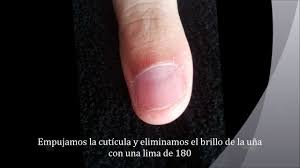In many cases an alteration in the nails can be a sign of suffering some internal disorder.
The nails are extensions of the epidermal tissue, that is, the membrane that forms the outer layer of the skin. In addition to the nails proper, it has three other parts: the nail matrix, located at its root, which is where the nail grows; the nail bed, located under the nail, which provides the nutrition, since the nail has no blood vessels that can do this function, and finally the nail fold, located above the matrix, in the part visible from the cuticle and surrounding skin.
Nails are often a manifestation of the state of the organism. This is because there are many internal diseases that affect them, such as, for example, metabolic disorders, liver cirrhosis or lung disorders. When this occurs, the nails become weak and suffer variations in color, shape and structure. In these cases, logically, the treatment should focus on combating the disease that has caused the change.
Certain skin conditions can also affect the nails. There are many, but three are the most common: psoriasis, lichen planus and alopecia areata.
Diseases of the skin
Psoriasis is a genetic disorder (not hereditary) that involves a renewal of the skin cells at a higher speed than normal. When it affects the matrix of the nail causes appear in this, depressed points, ie, areas where the nail sinks. Sometimes psoriasis appears only on the nails, without there being any sign of this alteration in the skin. The treatment is long and slow. It consists of the application of corticoid creams, and sometimes in the administration of injections next to the nail, also based on corticosteroids.
Lichen planus manifests itself in the form of depressed spots, streaks and red or purplish spots, and usually causes itching. It usually goes away on its own, but if after a while it persists, the dermatologist must prescribe corticoid creams.
Alopecia areata consists of hair loss in some areas of the scalp. Sometimes this capillary alteration is accompanied by an alteration in the nails, which also causes the appearance of depressed spots on its surface.

Infections and malformations
The nail can also suffer specific alterations. They are congenital (birth) or acquired infections and malformations that affect the nail matrix. Infections are caused by fungi and bacteria. The treatment is very slow, since the nails are not vascularized (they do not have blood vessels), reason why the medicines arrive to him with much difficulty. Congenic malformations can range from the total absence of the nails until the nails are deformed, and sometimes even affect the terminal part of the finger, which also deforms. The only problem these cases pose is the aesthetic, since it has no other negative consequences for the individual. The solution is to resort to artificial nails, although sometimes cause allergic reactions or eczema in the fingers.
The acquired deformations are mainly due to traumas (blows, catching a finger with a door ..). The nail is as before as it grows, even if the part that has suffered damage is dropped.
Congratulations @pachu4112! You have completed some achievement on Steemit and have been rewarded with new badge(s) :
Click on any badge to view your own Board of Honor on SteemitBoard.
For more information about SteemitBoard, click here
If you no longer want to receive notifications, reply to this comment with the word
STOP